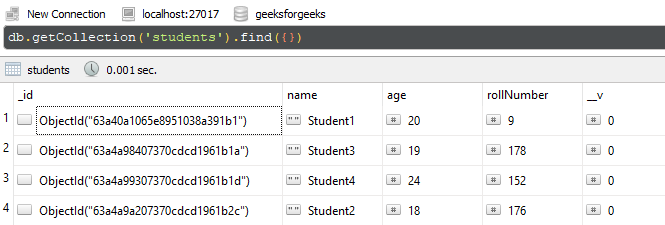Mongoose 聚合(Aggregate)API
Mongoose API 中的 聚合(Aggregate)API Aggregate() 方法用于执行聚合任务。它允许我们创建聚合管道。聚合构造函数用于构建和配置聚合管道。建议不直接实例化 Aggregation 类,而是在已经定义了 Mongoose 模式的任何模型上使用它。让我们通过一个示例来理解 aggregate() 方法。
语法:
Model.aggregate( <pipeline>, <model>);
参数: 该方法接受如下两个参数:
- pipeline: 用于指定对象的聚合管道数组。
- model: 用于确定我们将使用的模型名称与聚合管道一起使用。
返回值: 该方法以对象数组的形式返回结果集,根据聚合管道的要求。
设置Node.js的Mongoose模块:
步骤1: 使用以下命令创建一个Node.js应用程序:
npm init
步骤2: 创建NodeJS应用程序后,使用以下命令安装所需的模块:
npm install mongoose
项目结构: 项目的结构将如下所示:
数据库结构: 数据库的结构将会是这样的,以下的文档都存在于该集合中。
示例1: 在这个示例中,我们使用mongoose建立了一个数据库连接,并通过studentSchema定义了一个模型。最后,我们在mongoose模型上使用aggregate()方法并配置了管道。
文件名:app.js
// Require mongoose module
const mongoose = require("mongoose");
// Set Up the Database connection
const URI = "mongodb://localhost:27017/geeksforgeeks"
const connectionObject = mongoose.createConnection(URI, {
useNewUrlParser: true,
useUnifiedTopology: true,
});
const studentSchema = new mongoose.Schema({
name: { type: String },
age: { type: Number },
rollNumber: { type: Number },
});
const Student = connectionObject.model('Student', studentSchema);
Student.aggregate([{ $project: { name: 1, rollNumber: 1,
_id: 0 } }]).exec((error, resultSet) => {
if (error) {
console.log(error);
} else {
console.log(resultSet);
}
})
运行程序的步骤:
要运行该应用程序,请在项目的根目录中执行以下命令:
node app.js
输出:
[
{ name: 'Student1', rollNumber: 9 },
{ name: 'Student3', rollNumber: 178 },
{ name: 'Student4', rollNumber: 152 },
{ name: 'Student2', rollNumber: 176 }
]
示例2: 下面的示例演示了Mongoose API Aggregate的功能,使用了then和catch语句块。
文件名:app.js
// Require mongoose module
const mongoose = require("mongoose");
// Set Up the Database connection
const URI = "mongodb://localhost:27017/geeksforgeeks"
const connectionObject = mongoose.createConnection(URI, {
useNewUrlParser: true,
useUnifiedTopology: true,
});
const studentSchema = new mongoose.Schema({
name: { type: String },
age: { type: Number },
rollNumber: { type: Number },
});
const Student = connectionObject.model('Student', studentSchema);
Student.aggregate().project({ age: 1 }).then(resultSet => {
console.log(resultSet);
}).catch(error => console.log(error));
运行程序的步骤: 从项目的根目录中执行以下命令来运行应用程序:
node app.js
输出:
[
{ _id: new ObjectId("63a40a1065e8951038a391b1"), age: 20 },
{ _id: new ObjectId("63a4a98407370cdcd1961b1a"), age: 19 },
{ _id: new ObjectId("63a4a99307370cdcd1961b1d"), age: 24 },
{ _id: new ObjectId("63a4a9a207370cdcd1961b2c"), age: 18 }
]
参考: https://mongoosejs.com/docs/api/aggregate.html#aggregate_Aggregate
 极客教程
极客教程
